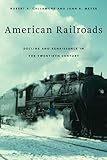American Railroads : Decline and Renaissance in the Twentieth Century / John R. Meyer, Robert E. Gallamore.
Material type: TextPublisher: Cambridge, MA : Harvard University Press, [2014]Copyright date: ©2014Edition: Pilot project,eBook available to selected US libraries onlyDescription: 1 online resource (523 p.) : 15 halftones, 14 line illustrations, 14 mapsContent type:
TextPublisher: Cambridge, MA : Harvard University Press, [2014]Copyright date: ©2014Edition: Pilot project,eBook available to selected US libraries onlyDescription: 1 online resource (523 p.) : 15 halftones, 14 line illustrations, 14 mapsContent type: - 9780674970793
- 9780674369368
- 385.0973/0904 23
- HE2751 .G337 2014eb
- online - DeGruyter
| Item type | Current library | Call number | URL | Status | Notes | Barcode | |
|---|---|---|---|---|---|---|---|
 eBook
eBook
|
Biblioteca "Angelicum" Pont. Univ. S.Tommaso d'Aquino Nuvola online | online - DeGruyter (Browse shelf(Opens below)) | Online access | Not for loan (Accesso limitato) | Accesso per gli utenti autorizzati / Access for authorized users | (dgr)9780674369368 |
Frontmatter -- Contents -- Preface -- Railroad Companies and Abbreviations -- 1 The Enduring American Railroads -- 2 The Ills of Government Regulation of Rail Rates and Services -- 3 The Policy Dilemma of Competition and Consolidation -- 4 The Impact of Rival Freight Modes on Railroads -- 5 The Decline of Railway Passenger Service, 1900–1970 -- 6 Merger s at Midcentury and the Penn Central Debacle -- 7 Two Railroad Reform and Revitalization Acts and the Northeast Rail Crisis in the 1970s -- 8 The Brief, Mainly Happy Life of Conrail, 1976–1999 -- 9 The Making of the Staggers Rail Act, and Experience under Deregulation -- 10 How Railroads Got Their Final Sizes and Shapes -- 11 The Enduring Problem of Rail Passenger Service in the Amtrak Era -- 12 Advancing Technology for American Railroads -- 13 Decline and Renaissance of American Railroads in the Twentieth Century – Pulling into the Terminal -- Afterword: Future Policies for US Railroads -- Notes -- Acknowledgments -- Index
restricted access online access with authorization star
http://purl.org/coar/access_right/c_16ec
Once an icon of American industry, railroads fell into a long decline beginning around the turn of the twentieth century. Overburdened with regulation and often displaced by barge traffic on government-maintained waterways, trucking on interstate highways, and jet aviation, railroads measured their misfortune in lost market share, abandoned track, bankruptcies, and unemployment. Today, however, as Robert Gallamore and John Meyer demonstrate, rail transportation is reviving, rescued by new sources of traffic and advanced technology, as well as less onerous bureaucracy. In 1970, Congress responded to the industry's plight by consolidating most passenger rail service nationwide into Amtrak. But private-sector freight service was left to succeed or fail on its own. The renaissance in freight traffic began in 1980 with the Staggers Rail Act, which allowed railroad companies to contract with customers for services and granted freedom to set most rates based on market supply and demand. Railroads found new business hauling low-sulfur coal and grain long distances in redesigned freight cars, while double-stacked container cars moved a growing volume of both international and domestic goods. Today, trains have smaller crews, operate over better track, and are longer and heavier than ever before. Near the end of the twentieth century, after several difficult but important mergers, privately owned railroads increased their investments in safe, energy-efficient, environmentally friendly freight transportation. American Railroads tells a riveting story about how this crucial U.S. industry managed to turn itself around.
Mode of access: Internet via World Wide Web.
In English.
Description based on online resource; title from PDF title page (publisher's Web site, viewed 08. Aug 2023)


